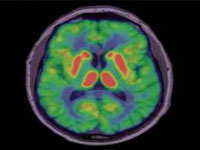据6月30日的《科学-转化医学》杂志报道,一项对2名接受了胚胎组织移植的帕金森氏病患者的新的研究提示,被称作运动障碍的突然、无法控制的身体运动(这是治疗帕金森氏病的一种常见的副作用)是因为在移植组织中存在过多的5-羟色胺细胞从而欺骗脑子释放多巴胺的一种结果。
该研究可使人们了解脑组织移植的长期的后果,并能够帮助改善未来的由移植来自不同来源细胞(如用生物工程设计的细胞或干细胞)所组成的试验。
1980年代在帕金森氏病患者身上所做的流产胚胎组织移植的前驱性外科手术证明了患病的脑子是可以修复的,至少在某些病例中是这样。
该治疗的目的是为了替换在帕金森氏病患者的脑中衰退的多巴胺细胞。 某些接受了移植术的患者症状出现了显著的改善,但他们中的大多数最终出现了运动障碍。 有关将胚胎细胞移植到成人中的争议使得在1980年代末美国的在人体所做的试验被终止,因为当时美国政府暂时性地禁止了对胚胎组织的研究,尽管该研究在世界其它地方仍然在继续进行。
美国在1990年代初解禁了胚胎组织的研究,但在这些病人中发生运动障碍的原因仍然是一个谜,而且人们没有发现对其的有效治疗方法。
如今,Marios Politis及其在英国和瑞典的同僚发现神经递质5-羟色胺是造成运动障碍的元凶。研究人员应用成像性扫描和放射性同位素指示剂从而能够在2名患者的脑中看到不同化学物质的功能。 在经过更加仔细的观察之后,他们发现先前衰退的多巴胺神经元(这是帕金森氏病的一个标志)在移植后的十年中仍然是修复的而且有着充分的功能。 但Politis及其同僚还看到了在移植组织中的始料未及的大量的5-羟色胺神经元。 这一发现令人困惑,因为在帕金森氏病中所常见的运动障碍被认为是多巴胺(而不是5-羟色胺)作用的一个结果。 研究人员发现,5-羟色胺神经元有转为一种不同的神经递质的欺骗能力(即被接纳并泵出多巴胺),从而引起运动障碍。给予一种可阻断这一作用的药物几乎可以立刻消除在这2位病人中的运动障碍问题。
文章的作者还提出,在未来的基于细胞的疗法中消除5-羟色胺可防止这一令人功能丧失的副作用。 最近,一项以TRANSEURO之名所启动的新的试验计划用胚胎细胞疗法来治疗帕金森氏病,而第一批的手术计划在2012年进行。
推荐原文出处:
Sci Transl Med DOI: 10.1126/scitranslmed.3000976
Serotonergic Neurons Mediate Dyskinesia Side Effects in Parkinson’s Patients with Neural Transplants
Marios Politis1,2,*, Kit Wu1,2, Clare Loane1,2, Niall P. Quinn3, David J. Brooks1,2, Stig Rehncrona4, Anders Bjorklund5, Olle Lindvall6,7 and Paola Piccini1,2
1Centre for Neuroscience, Division of Experimental Medicine, Faculty of Medicine, Hammersmith Hospital, Imperial College London, London W12 0NN, UK.
2Neurology Group, Clinical Sciences Center, Medical Research Council, Hammersmith Hospital, Imperial College London, London W12 0NN, UK.
3Sobell Department of Motor Neuroscience and Movement Disorders, Institute of Neurology, University College London, Queen Square, London WC1N 3BG, UK.
4Division of Neurosurgery, Lund University Hospital, Lund 221 85, Sweden.
5Neurobiology Unit, Wallenberg Neuroscience Center, Lund 221 84, Sweden.
6Laboratory of Neurogenesis and Cell Therapy, Wallenberg Neuroscience Center, Lund 221 84, Sweden.
7Lund Stem Cell Center, Lund 221 84, Sweden.
Troublesome involuntary movements in the absence of dopaminergic medication, so-called off-medication dyskinesias, are a serious adverse effect of fetal neural grafts that hinders the development of cell-based therapies for Parkinson’s disease. The mechanisms underlying these dyskinesias are not well understood, and it is not known whether they are the same as in the dyskinesias induced by l-dopa treatment. Using in vivo brain imaging, we show excessive serotonergic innervation in the grafted striatum of two patients with Parkinson’s disease, who had exhibited major motor recovery after transplantation with dopamine-rich fetal mesencephalic tissue but had later developed off-medication dyskinesias. The dyskinesias were markedly attenuated by systemic administration of a serotonin [5-hydroxytryptamine (5-HT)] receptor (5-HT1A) agonist, which dampens transmitter release from serotonergic neurons, indicating that the dyskinesias were caused by the serotonergic hyperinnervation. Our observations suggest strategies for avoiding and treating graft-induced dyskinesias that result from cell therapies for Parkinson’s disease with fetal tissue or stem cells.








